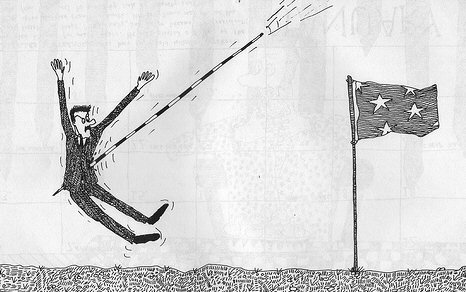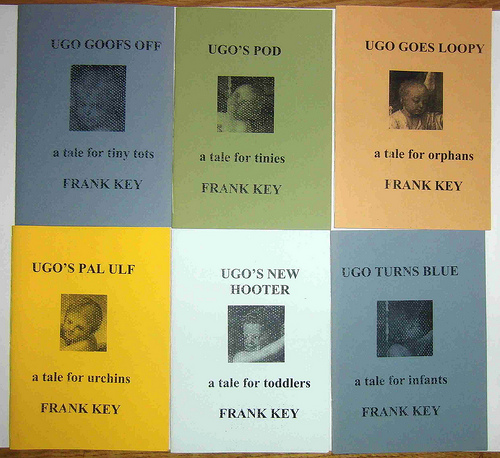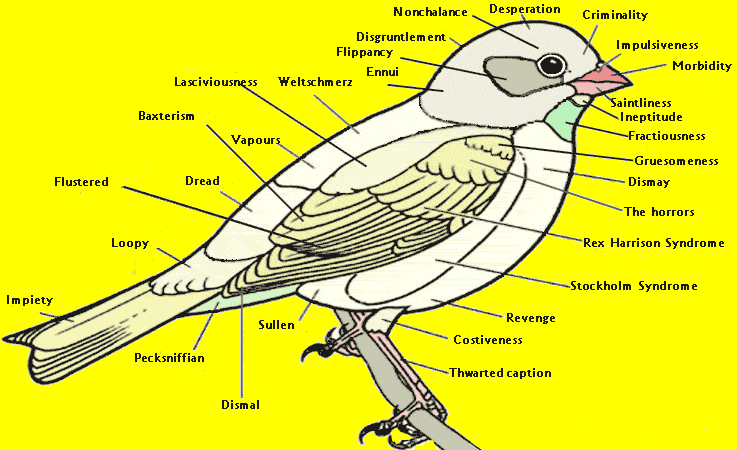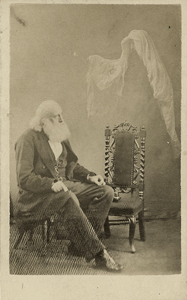Monthly Archives: March 2011
That Swanlike Simulacre
A thing which had a different, a horror-like beauty like a mad Goya etching, occurred when the black priestess did her death dance with the huge white turkey. Though far from feeble, possessed of great vitality, she was a slender woman, slightly formed, whose nervous strength lay not in muscular weight. When the turkey’s wings spread wide and began to flap frantically above her head as she whirled, the great bird seemed larger and more powerful than she; it seemed that she would be dragged from her feet, hurled to the ground, or flown away with fabulously into the sky. And as she sought finally to tear off its head, sought to clutch its body between her knees, it attacked her savagely, beating her face and breasts, beating at her so that she was at moments enfolded by the great white wings, so that bird and woman seemed to mingle struggling in a monstrous, mythical embrace. But her fatal hands were still upon its throat, and in that swanlike simulacre of the deed which for the male is always like a little death, it died.
So savage had this scene been that it was almost like an anticlimax when the sacrificial goat was now led through the doorway to the altar…
W B Seabrook describes his voodoo blood baptism in Haiti in The Magic Island (1929)
Tack And Paviour
One dreary morning I went walking along the perimeter of the owl sanctuary, past the decoy duckpond, beyond the pollarded willows by the canal just before the level crossing, and on to Blister Lane. The drizzle ceased, and through a sudden gap in the clouds a shaft of sunlight beamed down upon the paving slabs and the gutter, and I saw something glisten. Though still some yards away, I have piercing eyesight, and I saw it was a tack, a tack glinting in the light. I wondered if perhaps it had been discarded by an ironmonger or handyperson, deliberately, because it was an imperfect tack, or accidentally, through carelessness or stupidity or worse. When I reached the point on the paving alongside the gutter in which the tack had been abandoned, I stopped still. Looking at it, from my freakish height of six-foot-nine, I immediately knew it was made of brass. I am not a professional metallurgist, but over the course of my long life I have trained myself to identify any number of metals by sight, a skill which has proved useful in situations as diverse as quiz shows, cocktail parties, and mining disasters. Clouds shifted, the shaft of sunlight vanished, and the tack no longer gleamed. But there I was, standing over it, so what choice did I have? I got down to it. I do not mean that I “got down” in a groovy sort of way, daddy-o, as a soul singer might “get down”. No, I simply went down on my hands and knees, on the paving slabs, and then got down further, sprawling, as it were, flat upon the slabs, so that my body lay across Blister Lane while my head, and thus my eyes, were directly above the brass tack.
I was disporting myself thus, keenly eyeing the brass tack, when I heard footsteps approaching. I did not wish to block the path, so I sat up, and as I did so I popped the tack into my pocket. In spite of my civic-minded physical manoeuvering, the footstepper did not continue wending his way, but stopped short, looming above me.
“Are you alright?” he asked.
He was a thick-set fellow, head like a potato, and he was dressed in the dust ‘n’ muck-covered overalls of a labouring man. It occurred to me he might be the owner of the tack, out hunting for it.
“I am fine, thank you,” I said, from my sitting position, “I was just getting down to brass tack. It is now in my pocket. Does it belong to you, by any chance?”
“No,” he replied, “In my line of work I have no need for tacks. I am a paviour,” he added, “And I laid every paving slab for as far as the eye can see, including the one you are sitting on.”
“Oh, I’m sorry,” I said, getting to my feet.
“Not to worry,” said the paviour, “Well, now I have ascertained that you are not an invalid or otherwise incapacitated, I shall be on my way. I have paving to attend to elsewhere.”
“Of course,” I said, doffing my Homburg.
I went home and put the brass tack on the kitchenette floor, where I could in future get down to it at my leisure. Some authorities – Blodgett, for example – insist that one must have more than one brass tack to get down to, plural tacks, as it were, but such a hidebound view cuts no mustard with me. I know my onions.
Ooh! – Ugo, His Blind Ma, And His Pal Ulf
Look!
This is the set of six exceedingly rare out of print pamphlets available to the highest bidder in this weekend’s fundraiser auction on ResonanceFM. There are many more splendid items for which you can empty your pockets, so go here for further details.
The Ugo books contain heart-wrenching tales of Ugo and his blind Ma and his pal Ulf, set in the old town of Plovdiv. They are fully illustrated with black and white reproductions of details from some of the masterpieces of Western art. Each book, originally published in an edition of, I think, just twelve copies in 2004, is signed by the author and a dedication to the successful bidder will be added before they’re popped in the post.
Mysteries Of The Dabblecast
In my Dabbler cupboard this week I unveil the mysteries of the Hooting Yard podcast creation process. And while we are on the subject of ResonanceFM, make sure you tune in for this weekend’s fundraiser weekend, where you will get a chance to bid for a startlingly rare set of six out of print pamphlets by Mr Key!
Emerald Isle
To celebrate St Patrick’s Day, here is Michael Burleigh, writing in Sacred Causes : Religion And Politics From The European Dictators To Al Qaeda (2006):
Then there is ‘the culture’, which should not be confused with the occasional minor Irish poet winning the Nobel Prize for literature. Various provincial cliques and coteries, whether eccentrically Anglo-Irish, or just plain Irish, are inflated out of all proportion to their actual significance by their admiring fellows in the metropolitan British media. It is also depressing that the only celebrated visual art is the political graffiti – known as Muriels in Belfast – that adorns the ends of terraced housing. Hollywood contributes its quotient of surreal movies about nobly moody Irish terrorists allegedly facing agonising moral dilemmas, rather than the reality of intimidating drunks cutting (Republican Catholic) people’s throats in Belfast bars for such grave offences as spilling their drink, a practice that assumed global notoriety after the slaying of Robert McCartney (1971-2005). It can depict Irish-American cops as crooked or psychopathic in such movies as LA Confidential or Internal Affairs, but realism departs once the movies are about the emerald isle. Drink plays a large role in what is a deeply unattractive fusion of sentimentality and violence, where people are quick to take offence as Robert McCartney and Brendan Devine discovered (senior Belfast IRA figures stabbed and battered McCartney to death in Magennis’s bar after Devine had made an observation about one of the females in their company). Speaking of bars, dingy Irish theme pubs are ubiquitous in Europe, with their fake swirling Celtic tat and Guinness, and giant monitors for football and rugby, Gaelic or otherwise, which only partially drowns out the relentless, mindless gabbling known as ‘craic’. Some evenings these places are given over to interminable fiddle and jiggy music, or to tear-jerking rebel songs, although a truly weird cultural format, consisting of boys and girls hopping up and down with their arms rigid at their sides, has even made it on to the West End stage in London.
Things Beginning With B
Dobson’s pamphlet Things Beginning With B (out of print) is chiefly remarkable for the paucity of things beginning with B to which it attends. After a few ill-tempered prefatory remarks in which the twentieth century’s titanic pamphleteer gets off his chest certain moans and grumbles about rain and mud and swans, he embarks upon a surprisingly knowledgeable account of bees. This display of unlikely learning puzzled Dobsonists for many a year, until Aloysius Nestingbird discovered that the passage is copied out in its entirety from a Victorian work of natural history entitled Everything A Sickly Victorian Infant Needs To Know About Bees, Wasps And Hornets by Mrs Lachrima Baste.
Dobson next announces that he is going to give the most thorough account of breakfast ever attempted in English prose. He does not. Following a short paragraph about eggs, containing nothing that the average hen coop observer would not learn in a morning, the pamphleteer asserts that the “breakfast of the future” will be smokers’ poptarts, a product at that time newly introduced to the ever-burgeoning breakfast food market. While admitting that he has yet to try this toothsome savoury himself, Dobson sings the praises of the smokers’ poptart to so ludicrous an extent that one suspects he was in the pay of the manufacturers. As indeed he was. It was Nestingbird, again, who winkled out the embarrassing truth. Facing a large gas bill and a fine imposed upon him for an offence described as “throwing pebbles, with menace, at swans”, Dobson was more than usually desperate for cash, and it seems that when a representative from the smokers’ poptarts manufacturers’ association came a–calling, the pamphleteer struck a shabby deal. As hairy persons in the 1960s might have put it, he “sold out to The Man, man”.
Thus it is that the bulk of Things Beginning With B is nothing more than an extended paean to smokers’ poptarts, for having exhausted his flights of wittering guff about the breakfast product, Dobson brings the pamphlet to an abrupt close with the preposterous claim that, bees and breakfast aside, there is nothing much of any interest that begins with the letter B.
It is not known how much money Dobson received for his poptart puffery. The records show that, although the swans-and-pebbles-related fine was paid in full, his gas supply was cut off on St Creak’s Day of that year, and not reinstated until the first day of Vice President Nixon’s visit to Venezuela, as recounted in Six Crises (1962).
Overseas Jesuit
Mention of Dr Charlotte Bach’s tragically unrealised Aztec board game summoned to memory a family favourite from my childhood. Overseas Jesuit was a board game in which one rolled the dice and moved one’s counter across various dark and benighted continents, converting the heathen hordes by fire and sword. So simple were the rules that the game was suitable for even the tiniest young Catholic.
Aztec Fun For All The Family
A letter to John Waddington Ltd…
I understand your firm is the leading manufacturer of playing cards and games and that you are always on the look-out for novelties in this field.
Enclosed herewith please find reproductions of two pages from an ancient Aztec codex; kindly take a look at them.
I am a philosopher-psychologist, former lecturer at the University of Budapest. For the past few years I have been engaged in some rather abstruse socio-anthropological research. In the course of this work, as a sort of ‘spin-off’, I happen to have cracked the code of the Aztec-Maya-Omec Tonalpouhalli (‘ritual year’). This, even if I say so myself, is quite an important academic achievement and will undoubtedly create quite a stir in the appropriate circles when I publish my findings.
For your information – in case your acquaintance with the extinct Meso-American cultures is no longer up to specialist standard – the Tonalpouhalli was a ‘year’ consisting of 13 20-day ‘months’… The Nahuatl word ‘Tonalpouhalli’ translates as something like ‘the arithmetic of destiny’ and it forms the foundation of the Tonalamatl (‘The Book of Fate’) which consists of pictures only…
The reason I am telling you this is that, with the riddle solved, the Tonalamatl lends itself eminently well to a transformation into a game akin to the phenomenally successful Monopoly, as well as to an ordinary card game, as well as to a divinatory system similar to the Tarot cards… I feel that this holds considerable commercial possibilities.
A letter from Dr Charlotte Bach to John Waddington Ltd, quoted in Who Was Dr Charlotte Bach? by Francis Wheen (2002). Wheen notes “Messrs Waddington felt otherwise”.
94 Today!
Ornithological Anniversary
Astonishingly, today is the fifth anniversary of the publication of Blötzmann’s historic bird psychology diagram. Ornithologists throughout the world will be celebrating this landmark in a manner only ornithologists can, that is, by gathering upon promontories peering at the sky while munching filberts.
(Click on the diagram for a larger image,)
It is hard to put into words the earth-shuddering ramifications occasioned by Blötzmann’s diagram. Certainly it has had immeasurable effects upon the way we puny humans apprehend our beakéd, wingéd, airborne pals. I for one am reduced to dribbling with joy that I no longer languish in bird-ignorance, as I sadly did until this day five long years ago.
UPDATE : Inexplicably, several errors crept into the reproduction of Blötzmann’s diagram. The corrected version appears below, and will, again, loom larger should you click upon it.
Invisible Beings
Invisible Beings is a gallery of spirit photographs by Georgiana Houghton. You can read about her at Ptak Science Books, which tells us, inter alia, that she was in spooky ethereal contact with one Henry Lenny, a deaf and dumb artist who also happened to be dead.
Dabbling With Filberts
 Imagine your distress if, during the burial service of your dear departed, the vicar was seen to be chewing filberts! Or consider your consternation if, awaiting in her chamber the farmer’s wife with whom you were about to commit adultery, the door crashed open to admit, not the object of your illicit affections, but a fearsome bear! You can read about these and other shocking incidents from the late eighteenth-century, including the discovery of a submerged hazelnut hedge, in my cupboard at The Dabbler this week.
Imagine your distress if, during the burial service of your dear departed, the vicar was seen to be chewing filberts! Or consider your consternation if, awaiting in her chamber the farmer’s wife with whom you were about to commit adultery, the door crashed open to admit, not the object of your illicit affections, but a fearsome bear! You can read about these and other shocking incidents from the late eighteenth-century, including the discovery of a submerged hazelnut hedge, in my cupboard at The Dabbler this week.
Important Signage
The world may be going to hell in a handcart, but there is at least once certainty to which we can cling. Things fall apart, the centre cannot hold, but every day Outa_Spaceman staples into place a new cardboard sign. And I am inordinately pleased with the latest one, for obvious reasons:
Mayonnaise And Bleach
On Thursday last, while trotting through the park, the parson was unhorsed, and fell into a ha-ha. Torrential rainfall during the previous week had filled the ditch with puddles, and when he clambered out, the parson was sopping wet. His horse had galloped away, and was nowhere to be seen, so the parson faced the prospect of having to walk the many miles back to his parsonage. The weather remained inclement, although it was no longer raining.
At this juncture, the parson felt the presence of the uncanny, just behind him. He span around, and saw an angel. Its wings were furled, its locks were golden. In one hand, it held a jar of mayonnaise, in the other a bottle of bleach. The parson was surprised to note that it wore black leather gloves.
“Take this jar and take this bottle,” said the angel. So mellifluous was its voice that the parson near swooned. He reached out, and took the mayonnaise and the bleach, and as soon as he did so, the angel vanished. Where it had stood there was a haze of gaseous mist. The parson was sore perplexed.
Just then, as astronomers had foretold, there was a partial eclipse of the sun and, as seismologists had foretold, a minor earthquake shook the ground on which the parson stood. He nearly toppled over, and would have fallen back into the ha-ha, and possibly smashed the jar and the bottle, both of which were glass, but he was a parson of stupendous balance. All the more surprising that he had been unhorsed.
The partial eclipse made the park dark. But in its jar, the mayonnaise had a creamy glow. The parson held it aloft, and it lit him on his way as he began his long journey home.
*
Having read the piece aloud to your class, posit the following questions. Allow the time indicated in each case for the tinies to scratch the answers upon their slates.
Why do you think the parson was unhorsed? (30 seconds)
What kind of angel would wear gloves? (30 seconds)
How likely is it that an eclipse and an earthquake would happen at the same time? (15 seconds)
Why did the angel present the parson with a bottle of bleach? (90 seconds)
Do you think the horse found its own way back to the parsonage? (30 seconds)
Of which noble gases would the haze of mist be composed? (120 seconds)
Now get the class to retell the story in such a way that the parson and the angel and the horse all swap rôles. (6 hours)






